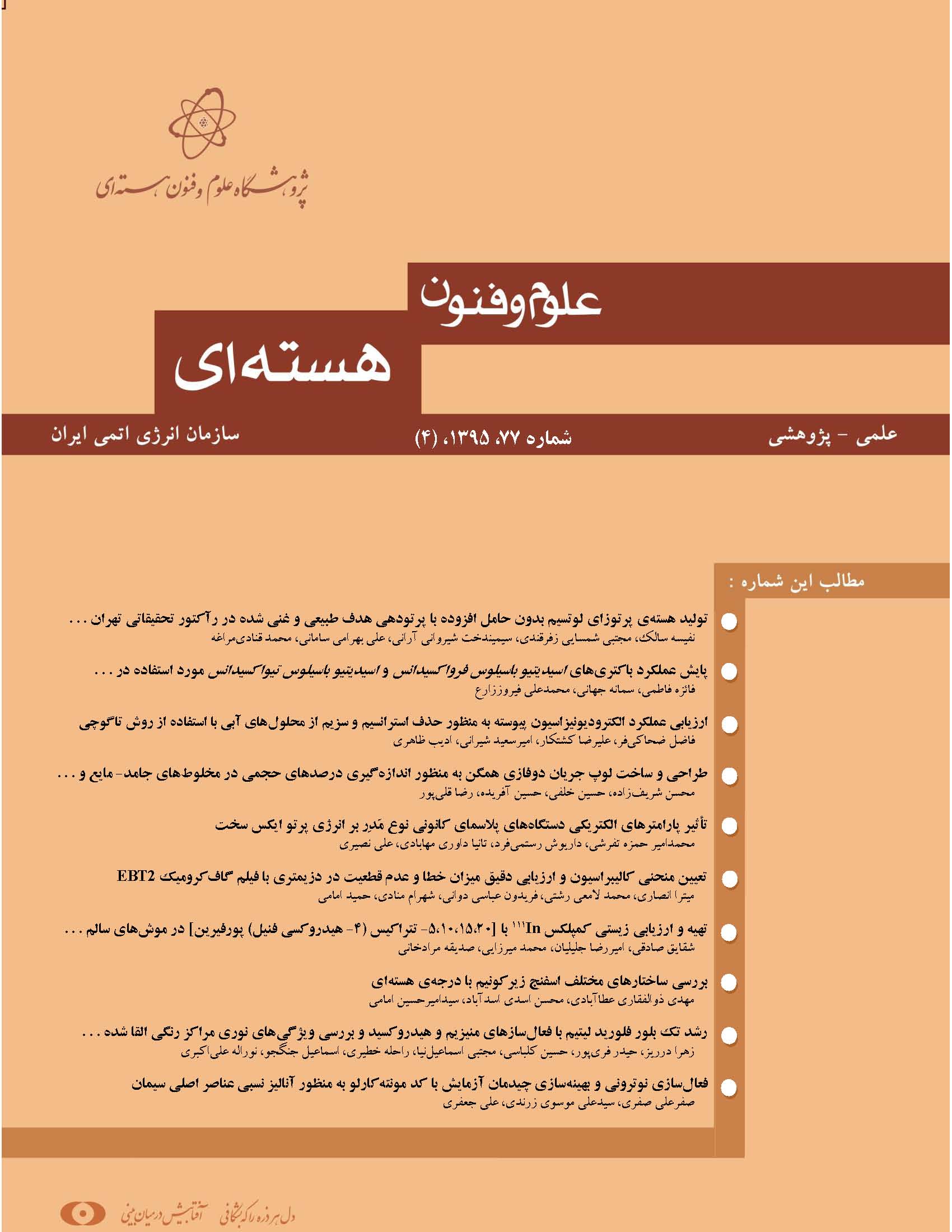نوع مقاله : مقاله پژوهشی
نویسندگان
1 پژوهشگاه علوم و فنون هسته ای، سازمان انرژی اتمی ایران،
2 پژوهشگاه علوم و فنون هستهای، سازمان انرژی اتمی ایران
چکیده
هدف از این پژوهش، سنتز کمپلکس [111In-THPP] و ارزیابی آن به عنوان عامل تصویربرداری جدید است. رادیوداروی 111In]InCl3]، با استفاده از 111In]InCl3] و لیگاند 5،10،15،20- تتراکیس (4- هیدروکسی فنیل)- پورفیرین (THPP) در دمای 800C و به مدت min60 سنتز شد. هستهی پرتوزای 111In از طریق بمباران کادمیم طبیعی با باریکهای از پروتونهای MeV30 و جریان µA150 در سیکلوترون حاصل شد. جداسازی به روش کروماتوگرافی یونی صورت گرفت و بازدهی جداسازی رادیوشیمیایی بیشتر از 98% به دست آمد. برای مشاهدهی درصد نشاندارسازی یا به عبارتی برای اطمینان از فلزدار شدن پورفیرین، از دستگاه RTLC و HPLC استفاده شد (با خلوص رادیوشیمیایی بالاتر از 99% در هر دو روش). ترکیب نشاندار به موشهای سالم تزریق، و پراکنش زیستی آنها در فاصله زمانی 2 تا h24، در ابتدا با استفاده از اندازهگیریهای دوربین گاما، و در نهایت با استفاده از مطالعات پراکنش بافتی، ارزیابی و بررسی شد. مطالعات پراکنش زیستی نشاندهندهی تجمع قابل قبول کمپلکس در کلیهها نسبت به سایر بافتها بود. کمپلکس اساساً از طریق کلیهها دفع میشود و از آنجا که جذب در کبد بسیار کم و دفع از آن سریع است، میتواند عاملی سودمند در ردیابی و تصویربرداری قلمداد شود.
کلیدواژهها
عنوان مقاله [English]
Preparation and Biological Evaluation of [111In]-THPP [5, 10, 15, 20-tetrakis (4-Hydroxyphenyl) Porphyrin] Complex in Healthy Rats Via SPECT Imaging
نویسندگان [English]
- A.R Jalilian 1
- Sh Sadeghi 2
- M Mirzaii 2
- S Moradkhani 2
چکیده [English]
The aim of this research was the synthesis of 111In-THPP, and its evaluation as a new imaging agent. The 111In-THPP radiotracer was synthesized by 111InCl3 and 5, 10, 15, 20-tetrakis (4-hydroxyphenyl) porphyrin) (THPP) in solution for 60 min at 80˚C. In-111 radionuclide was produced from proton bombardment of natCd target using 30MeV protons and 150μA current. Separation was achieved using ion chromatography method with the separation yield of >98%. In order to determine the radiolabeling yield (or metallation) radio thin layer chromatography (RTLC) and high performance liquid chromatography (HPLC) were used (with the radiochemical yield of >99% for both methods). The radiolabeled compound was injected to the healthy rats and the biodistribution studies were performed using scarification. The single photon emission computed tomography (SPECT) imaging within 2-24h shows the accumulation of 111In-THPP in the kidneys, compared to other organs. 111In-THPP is essentially excreted via kidneys. Due to relatively low liver uptake and kidney wash-out, 111In-THPP could be a potential agent for imaging.
کلیدواژهها [English]
- Hydroxyphenyl Porphyrin
- Indium
- Biodistribution
- SPECT

